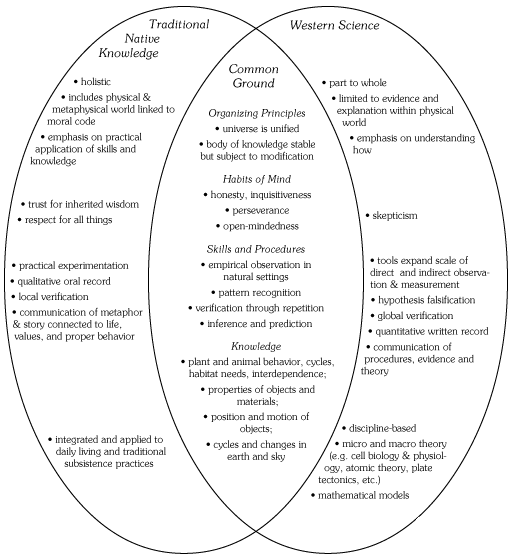

|
|
|
Integrating Traditional Native |
|
|
Perspectives Over the course of the last several years there has been lots of discussion about the fit between traditional Native knowledge and Western science. Opinions expressed have run all the way from “they are mutually exclusive systems” to “they are equivalent systems” and everywhere in between. We believe such disagreement and even polarity results from the human tendency to view things from your own spot in the world, and that thoughtful consideration of these two knowledge systems reveals much common ground (see diagram on facing page). We also believe that the work of creating culturally responsive science curriculum is context specific, dynamic and ultimately reflective of what one believes, values and thinks worth knowing. For many Native educators, culturally responsive science curriculum has to do with their passion for making cultural knowledge, language and values a prominent part of the schooling system. It has to do with presenting science within the whole of cultural knowledge in a way that embodies that culture (see Traditional Native Knowledge circle on facing page), and with demonstrating that science standards can be met in the process. It also has to do with finding the knowledge, strategies and support needed to carry out this work. For those educators not so linked to the local culture, culturally responsive science curriculum has more to do with connecting what is known about Western science education to what local people know and value (see Western Science circle). It has to do with accessing cultural information, correlating that information with science skills and concepts, adjusting teaching strategies to make a place for such knowledge, and coming to value a new perspective. It too has to do with addressing science standards and finding the knowledge, strategies, and support needed to carry out this work.
Implications Although educators obviously differ in their perspective, there is no doubt that the creation of culturally responsive science curriculum has powerful implications for students for at least three reasons. The first is that a student might conceivably develop all of the common ground skills and understandings while working from and enhancing a traditional knowledge base. The second is that acquisition of the common ground, regardless of route, is a significant accomplishment. And the third is that exploration of a topic through multiple knowledge systems can only enrich perspective and create thoughtful dialog. One way of envisioning this merger would be for young children to consistently focus on traditional knowledge as a way of enhancing a cultural foundation and developing skills and knowledge common to both systems. As children get older, this traditional focus might continue with increased use and discussion of some of the tools and procedures of Western science and how they differ from traditional ways of knowing. By middle/high school, students could tackle more sophisticated science concepts/skills and develop more sophisticated cultural understanding while also becoming more able to apply them in the real world, and more able to analyze and compare the insights and limitations of each system. In this way, students could have a truly rich and relevant education without demeaning or subjugating either knowledge system.
|
|
 |
|